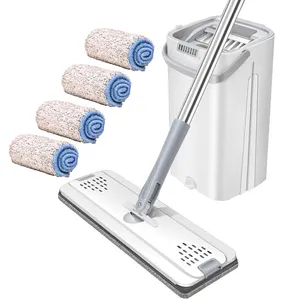(72789 products available)
























































































































































































Mops are essential cleaning tools used to clean and maintain floors. They come in various types, each designed to cater to different cleaning needs and preferences. While traditional mops, such as cotton and string mops, remain popular for their absorbent qualities, modern innovations have introduced a diverse range of options to consider. These include sponge mops, dust mops, wet and dry mops, and more. Each type is designed to tackle specific cleaning tasks and can be used on various floor surfaces, making them indispensable for households, businesses, and institutions.
String mop
This mop has long pieces of cloth called strings. They are usually made from cotton or microfiber. It is great at soaking up water, so it works well for big spills or cleaning large areas. One can wring out a string mop easily by twisting it or using a built-in press. This makes it helpful for cleaning floors in places like homes, schools, and businesses.
Flat mop
This mop has a flat cleaning pad attached to a rectangular or square head. The cleaning pad is often made of microfiber material that picks up dirt well but can be washed and reused. Flat mops are slim and easy to handle, making them perfect for cleaning floors in tight places like corners or under furniture. They are also good for quick daily cleaning because they can easily remove dust and spills.
Sponge mop
A sponge mop usually has a long handle and a sponge at the bottom. The sponge is great for soaking up water and cleaning. To use it, one pushes the mop forward and backward over the floor. It works well on smooth surfaces like tiles and laminated floors. One can wring it out easily using a special lever or press mechanism. This makes sponge mops helpful for daily cleaning of larger floors.
Dust mop
A dust mop has long, soft fibers that sweep up dirt, dust, and hair without much effort. It is not meant to get wet or clean stains with water. Instead, one uses it regularly to keep floors looking nice and clean. The handle of a dust mop is usually long, so one doesn't have to bend over while using it. It is suitable for large areas like homes, schools, and offices.
Wet mop
Wet mops are used to clean up dirt, spills, or stains with water. Their absorbent materials pick up liquids and wipe away messes. They are often used in kitchens, bathrooms, or commercial spaces where quick liquid cleanup is needed. Wet mops are simple and effective tools for maintaining cleanliness with water.
Dust mop
Dry mops are great for picking up dust, dirt, and hair from floors. They usually have soft, fluffy materials that trap dust so that it doesn't fly around. This makes dry mops perfect for daily cleaning to keep floors looking nice without scratches. They are safe for all floor types, including hardwood, tile, and laminate. Many have long handles for easy use and storage.
Microfiber mop
A microfiber mop has a head made of many tiny, soft fibers that pick up dirt and dust really well. These fibers can reach into small spaces and fit into corners, making them great for cleaning floors in homes and businesses. Microfiber mops are washable and reusable, so they are good for the environment and save money over time.
Steam mop
Steam mops use the power of hot water vapor to clean floors without chemicals. The steam from the mop head loosens dirt, and germs are wiped away by the cloth pad underneath. Steam mops are easy to use - just glide them back and forth over the floor surface. They are popular for cleaning hard surfaces like tile and sealed wood floors. Using steam is a natural and efficient way to sanitize floors, kill bacteria, and freshen up without harmful cleaning solutions.
Design matters when it comes to floor mops. Aesthetically pleasing mops that are created with practicality in mind will motivate people to clean their floors more often. Several important design elements make mops efficient and user-friendly.
Style and Color:
The style and color of a mop can make a big difference in how appealing it looks on the market. Bright colors or neutral tones with stylish patterns are attractive to the eyes, while classic designs suit people's tastes. The floor mop's appearance influences customers' emotions and motivates them to buy it for home cleaning purposes.
Materials:
Floor mops are made from various materials to ensure durability and ease of cleaning. The handle is usually made from stainless steel, aluminum, or plastic, while the mop head is made from cotton yarn, microfiber cloth, sponge, or synthetic fabric. The material choice affects the mop's performance, durability, and ability to pick up dirt and dust.
Shape:
The mop head shape determines how well it cleans different surfaces. A rectangular-shaped mop provides efficient coverage on floors and can clean walls, while a triangular one can reach into corners and crevices easily. Flat mop heads slip under furniture easily, whereas traditional ones with fringes or pads cover more ground in less time.
Components:
Essential components of a floor mop include a handle, mop head, and wringing mechanism. The handle is the long part held by the user, the mop head makes contact with the floor to pick up dirt, and the wringing mechanism (like a bucket or built-in press) squeezes out excess water from the mop cloth/pad.
Functional Features:
Many modern mops have detachable mop heads that can be washed separately or replaced when worn out. Some designs, like the swivel mops, offer jointed mop heads that rotate around for easy floor cleaning in tight spaces. Integrated features like spray mechanisms, steam technology, and efficient wringing systems enhance the usability and performance of mops.
Cleaning the Floor
Whether it is a commercial or residential space, mopping is done to clean the floor. Mopping removes dirt, dust, stains, and debris from the floor surface. It is an important cleaning task that keeps the floors hygienic and presentable.
Regular Maintenance
For routine cleaning and maintenance, mopping is done regularly, such as daily, weekly, or bi-weekly, depending on the foot traffic and cleaning standards. In areas with high foot traffic, such as commercial spaces, floor cleaning is done daily to remove dirt and dust. Residential cleaning can be done weekly or bi-weekly.
Cleaning Spills and Messes
Mopping quickly cleans up liquid spills, food messes, or other stains. Immediately after a spill, floor cleaning is done to remove the dirt and avoid slipping hazards.
Deep Cleaning
In some cases, the regular cleaning mop may not be enough, and a deep clean is required. It removes stubborn stains, ingrained dirt, or odors. Deep cleaning can be done periodically, such as seasonal or monthly, and involves special cleaners, equipment, and techniques.
Preparing for Events or Guests
Before hosting an event or having guests over, floors are mopped to ensure the space is clean and presentable. A quick mop before such occasions makes a big difference and leaves a good impression on visitors.
Post-Construction or Renovation Cleaning
After construction, floor surfaces are often dirty with dust, debris, and materials. Mopping is an important part of the post-construction cleanup process to remove such messes and make the space usable again.
Medical or Food Industries
Mopping is done in specialized environments such as hospitals, clinics, restaurants, or food processing areas. These industries have strict cleanliness and hygiene standards. For example, in a restaurant, the kitchen floor must be clean to avoid food contamination.
Floor Care and Maintenance
Mopping removes dirt and debris that can damage the floor or cause wear and tear. Regular floor cleaning increases the lifespan of the flooring material.
Floor type
When considering which mop to buy, think about the kind of floors most often found in the home. For example, hardwood floors need special care, so a mop with soft fibers that won't scratch the surface is ideal. Tile floors, on the other hand, can handle almost any kind of mop since they are tougher. If a lot of laminate flooring is present, it's best to avoid mops with wringing mechanisms that could damage the laminate. A microfiber flat mop or dust mop would work well instead. Ultimately, the best mop for one's needs will depend on the types of flooring in their house and what cleaning methods they prefer.
Cleaning efficiency
Consider the cleaning efficiency of each type of mop. Traditional mops may require frequent rinsing to remove dirty water, while flat mops and steam mops are designed to trap dirt and dust for efficient cleaning. Think about how much time and effort is required to mop the floors using different mops, and choose one that offers good cleaning efficiency.
Convenience and ease of use
Consider the convenience and ease of use of each type of mop. Traditional mops may require a bucket of water, which can be cumbersome and messy. Flat mops and spray mops are designed for quick and easy cleaning, making them more convenient for busy households. Also, consider the weight and maneuverability of the mop. Choose a mop that is easy to handle and store, making floor cleaning an enjoyable and less tiring task.
Versatility
Consider the versatility of each type of mop. If one wants a mop that can be used on different types of floors, a flat mop or spray mop may be a good choice. These mops can be used on hardwood floors, tile floors, and laminate floors, making them versatile for floor cleaning. Additionally, some mops come with detachable cleaning pads that can be used for various cleaning tasks, such as dusting or washing windows.
Budget
Consider the budget when choosing a mop. Traditional mops are usually affordable, but flat mops and spray mops may be more expensive. However, remember that investing in a good-quality mop can save money in the long run, as it can last longer and provide better cleaning efficiency.
Q: Why is floor mopping important?
A: Mopping floors on a regular basis removes dirt, dust, and debris, promoting a hygienic environment and extending the life of flooring.
Q: What is the best way to mop floors?
A: The best way to mop floors is to sweep or vacuum first, then use a suitable floor cleaner with a mop, making sure not to saturate the floor.
Q: How often should floors be mopped?
A: High-traffic areas should be mopped at least once a week, while less-trafficked areas can be mopped bi-weekly or monthly.
Q: What should be avoided when mopping floors?
A: Avoid using excessive water, harsh chemicals, or dirty mop heads when cleaning floors.
Q: How can one maintain a mop?
A: Mops should be washed with clean water after use and stored in a dry place.